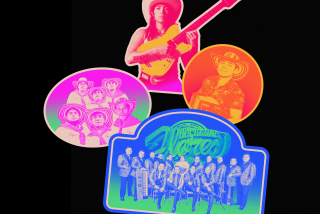MUSIC REVIEW
As frequent Los Angeles Philharmonic guest conductor Miguel Harth-Bedoya pointed out, Tuesday night’s Hollywood Bowl concert had a unifying theme. Every piece on the program was written by a French composer, and every piece was affected by the “Spanish tinge” -- as Jelly Roll Morton put it -- to some degree. Sometimes you had to listen hard to find Spain in the sound, but it was there.
It was the kind of classical program that symphonic pops conductor and once-perennial Bowl visitor Erich Kunzel -- who passed away Tuesday at the age of 74 -- would have felt at home in. At the same time, it was a type of program that has been rendered obsolete over the decades as film and TV music, pop culture, Lloyd Webber salutes and the like hijacked the summer pops trade. Kunzel played a big part in making this transition happen, but he didn’t let go of the old classical favorites altogether.
Three out of four of Harth-Bedoya’s selections fell into the bonbons category -- the Bacchanale from Saint-Saens’ “Samson And Delilah,” a de facto suite of hit tunes from Bizet’s “Carmen,” and Ravel’s vamp of vamps, “Bolero.” The lone exception was Lalo’s Cello Concerto, which cellists often record but don’t seem to play much in concerts these days.
The Lalo piece doesn’t really get your attention until it is about half over. After the thick Romantic pomposities of the first movement, you nearly give up -- but then, in the middle of the second movement, the orchestra suddenly launches into a delicate, irresistible Spanish two-chord vamp as the cello riffs away. The Spanish tinge to the rescue. Unfortunately, this passage and its reprise didn’t make much of an impression in the noisy outdoors - nor did the esteemed cellist Lynn Harrell’s cool, even-tempered, perhaps too mild-mannered playing through the entire concerto.
Elsewhere Harth-Bedoya ran through the Bacchanale at a comfortable pace, and waited until the close of the Gypsy Dance to work up some real steam in the “Carmen” suite.
“Bolero,” though, was a revelation. Ravel actually made a recording of his biggest hit on 78s in 1930, enforcing what might seem like a doggedly slow tempo to us. Well, Harth-Bedoya managed to hit Ravel’s tempo on the button (by my stopwatch, matching Ravel’s 16 minute, 7 second recording to the second!), and as a result, the piece gains a menacing, obstinate momentum. Everyone soloed well, getting their time on the video screens artfully cross-faded with the tapping of the snare drum.
--
More to Read
The biggest entertainment stories
Get our big stories about Hollywood, film, television, music, arts, culture and more right in your inbox as soon as they publish.
You may occasionally receive promotional content from the Los Angeles Times.










